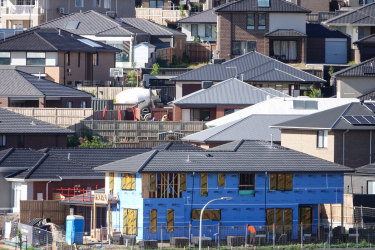The largest one-month jump in house values in 17 years and a surge in new home loans has prompted warnings the property market is at risk of overheating and could force the Reserve Bank to reassess record-low interest rates.
Some economists believe the RBA, which meets on Tuesday, may have to start lifting rates as early as next year to deal with house prices, which rose 3 per cent in Sydney and 2.5 per cent in Melbourne last month.
House values climbed at their fastest rate in 17 years in February and home loans are surging in reaction to ultra-low interest rates and government support programs.Credit:Paul Rovere
CoreLogic reported Sydney’s median house price has reached $1,061,229, up 4.8 per cent over the past three months, while in Melbourne it has climbed 4.2 per cent to $829,509.
Prices are on the rise across the country. In regional Tasmania, dwelling prices are up 13.8 per cent over the past year and house values in Canberra, Hobart and Darwin have increased more than 10 per cent over the same period despite the deepest recession since the 1930s.
Nationally, prices rose by 2.1 per cent over the four weeks of February – the single largest monthly jump since August 2003 – aided by ultra-low interest rates and federal and state government COVID-19 support programs.
Separate Australian Bureau of Statistics figures released on Monday show potential home buyers are increasingly prepared to take on more debt to get a foothold in the property market.
Home loans jumped by 10.5 per cent in January to be 44.3 per cent higher than a year ago. Loans excluding refinancing are up by 110 per cent over the past year in Western Australia, 74 per cent in Queensland and 39 per cent in Victoria.
First-home buyer loans rose by 10.1 per cent to be 73 per cent up over the past 12 months. More than half of all loans sold in January in WA were to first-time buyers while in Victoria 46 per cent were new to the market.
Owner-occupiers are now starting to battle investors who have re-entered the market, with investment property loans up by 9.4 per cent.
It is not just the property market strengthening. ANZ’s monthly measure of job ads rose by 7.2 per cent in February after climbing 2.6 per cent in January and is now 13.4 per cent up over the past 12 months, reaching its highest level since October 2018.
The RBA has signalled it does not expect to lift official interest rates from 0.1 per cent before 2024.
But among economists taking part in The Sydney Morning Herald/The Age Scope survey, two believe there could be a rate rise as soon as late 2022. University of Melbourne professor Neville Norman predicts an increase in the fourth quarter and Bankwest Curtin Economics Centre’s Rebecca Cassells forecasts one in the third. Another three believe rates could start to rise in 2023.
AMP Capital chief economist Shane Oliver said several factors were driving the property market, including government incentives, the unleashing of pent-up demand, the removal of responsible-lending obligations and a “fear of missing out”.
He said prices could climb another 5 to 10 per cent, which would start to worry the RBA.
“The acceleration in home prices is likely to be starting to concern the RBA – but with average prices only just surpassing their 2017 high, growth in housing debt remaining relatively subdued at 3.6 per cent year on year and little evidence of a significant deterioration in lending standards at present, it and APRA [the Australian Prudential Regulation Authority] are unlikely to reach for the macro-prudential lever just yet,” he said.
Westpac chief economist Bill Evans said low interest rates would remain part of the economic landscape for a long time.
“RBA policies are needed to remain stimulatory for a number of years; macro-prudential policies to deal with damaging asset bubbles should be applied if necessary with a view to a ‘soft landing’ for markets rather than the sharp deterioration we saw in 2017-19,” he said.
Start your day informed
Our Morning Edition newsletter is a curated guide to the most important and interesting stories, analysis and insights. Sign up to The Sydney Morning Herald’s newsletter here, The Age’s here, Brisbane Times’ here, and WAtoday’s here.
Most Viewed in Politics
Source: Read Full Article







